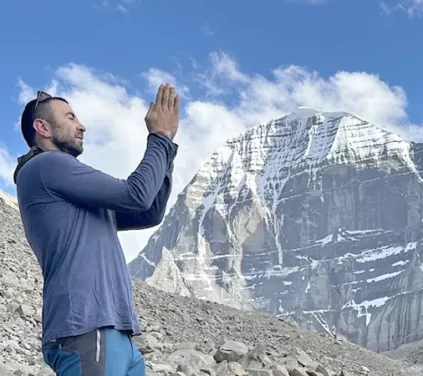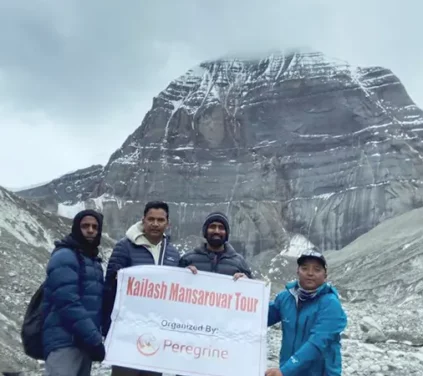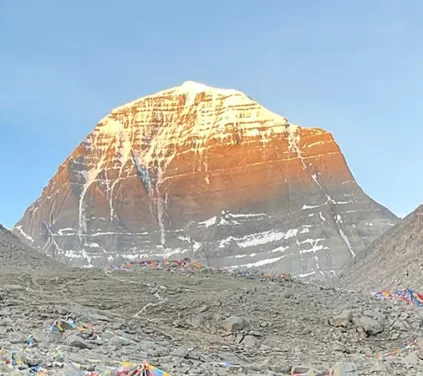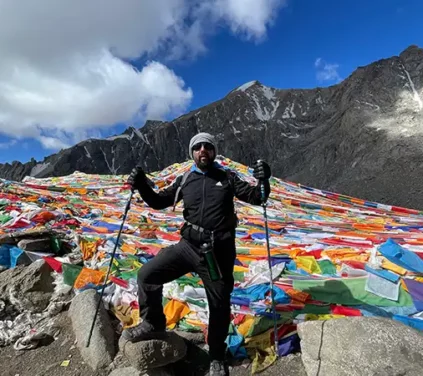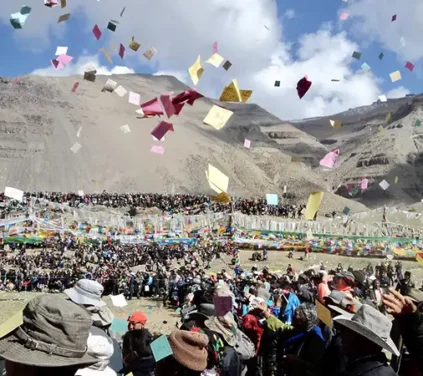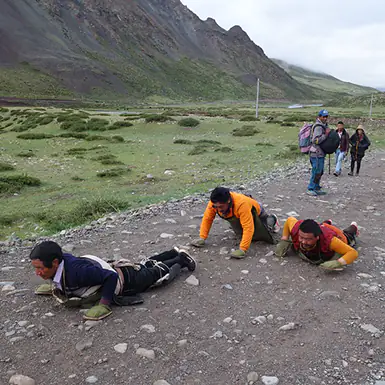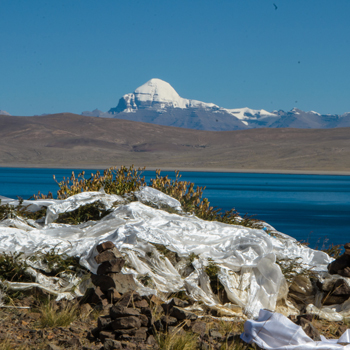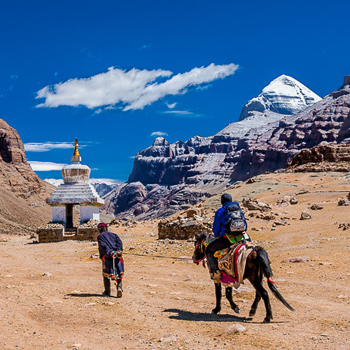Kailash Tour Package
Kailash Tour Package Travel Information
Mount Kailash, a revered peak on the Tibetan Plateau, holds spiritual significance for Hindus, Buddhists, Jains, and Bon followers. The Kailash Mansarovar Yatra provides a chance to experience this sacred mountain’s awe-inspiring beauty and profound spiritual energy. This guide delves into the spiritual importance and geographical marvels of Mount Kailash, providing essential insights for those considering a Kailash Tour, Kailash Yatra, or Mount Kailash Pilgrimage.
Spiritual Significance of Mount Kailash
Mount Kailash is pivotal in Hinduism, Buddhism, Jainism, and Bon, making it a spiritual nexus for millions worldwide.
Hinduism
Hindu mythology considers Mount Kailash to be the abode of Lord Shiva, the deity associated with destruction and transformation. Pilgrims undertake the Kailash Yatra to seek blessings and spiritual enlightenment. Circumambulating the mountain is considered a path to salvation, washing away sins accumulated over a lifetime.
Buddhism
For Buddhists, Mount Kailash is the home of Demchok (Chakrasamvara), a deity representing ultimate bliss. The mountain is a site for profound meditation and is central to several Buddhist teachings. The Mount Kailash Pilgrimage is a journey towards inner peace and understanding the Buddha’s path.
Jainism
Jains revere Mount Kailash, where their first Tirthankara, Rishabhadeva, attained liberation. The mountain symbolizes spiritual ascension and the triumph over earthly desires. A Kailash Tour allows Jain devotees to connect deeply with their faith’s origins.
Bon Religion
In the ancient Bon tradition of Tibet, Mount Kailash is the sacred nine-story Swastika Mountain, the world’s axis. It is considered the seat of spiritual power and a place where the founder of Bon descended from the heavens.
Myths and Legends
Countless myths and legends surround Mount Kailash and Lake Mansarovar. Tales of divine battles, mystical events, and the mountain as a portal to other worlds are deeply woven into the lore of these sacred sites. These legends bring a magical charm to the Kailash tour package, making the journey even more meaningful for pilgrims and travelers.
Geographical Overview of Mount Kailash
Mount Kailash is both a spiritual symbol and a natural marvel, drawing in adventurers and nature lovers alike.
Location on the Tibetan Plateau
Mount Kailash in the remote southwest corner of Tibet soars to 6,638 meters (21,778 feet). The mountain is part of the Trans-Himalaya range and is the source of some of Asia’s longest rivers, including the Indus, Sutlej, Brahmaputra, and Karnali.
Surrounding Landscapes
The area around Mount Kailash offers a stark yet stunning landscape. The terrain features rugged mountains, vast plains, and serene lakes like Lake Mansarovar and Lake Rakshastal. These lakes are integral to the spiritual significance of the Kailash Tour, making them essential parts of the pilgrimage experience.
- Lake Mansarovar: Mansarovar Lake, often regarded as the world’s highest freshwater lake, is believed to have purifying powers capable of cleansing sins and healing ailments.
- Lake Rakshastal: Rakshastal, often called the “Lake of Demons,” starkly contrasts the serene Mansarovar Lake, adding a layer of mythical intrigue to the region.
Natural Beauty
The region’s natural beauty is awe-inspiring. Snow-capped peaks, clear blue skies, and the silence of the high plateau create an atmosphere of tranquility. Wildlife such as yaks, Tibetan antelope, and various bird species can be spotted, enhancing the appeal of the Mount Kailash Pilgrimage.
Climate and Environment
The high-altitude environment presents a unique climate. Summers are mild, making it the best time for a Kailash Yatra, while winters are harsh and bleak. The thin air at high elevations requires acclimatization, an essential consideration for travelers booking a Kailash Tour Package.
Tour Duration and Highlights
Typical Length of the Tour
The Kailash Tour Package usually spans 12 to 15 days, providing ample time to experience the spiritual essence of the Kailash Yatra. This duration allows travelers to acclimatize to the high altitudes and fully engage in the Mount Kailash Pilgrimage without feeling rushed.
Key Destinations Included in the Package
- Lhasa: Begin your Kailash Tour in Tibet’s historic capital, exploring sites like the Potala Palace and Jokhang Temple.
- Shigatse: Visit the Tashilhunpo Monastery and immerse yourself in Tibetan culture.
- Saga: A crucial stopover town offering stunning views of the Brahmaputra River.
- Lake Manasarovar: A sacred lake revered in Hinduism and Buddhism, ideal for meditation and reflection.
- Darchen: The base town at the foot of Mount Kailash, serving as the starting point for the pilgrimage.
- Mount Kailash Kora: Undertake the 52 km circumambulation around Mount Kailash, the highlight of the Kailash Yatra.
- Dirapuk and Zutulpuk Monasteries: Key spiritual sites along the pilgrimage route.
- Gyirong Valley: Experience lush forests and Sherpa culture near the Nepal-Tibet border.
Types of Packages
Standard Group Tours
Standard group tours are ideal for travelers seeking a communal experience on the Kailash Tour. Features include:
- Fixed Departure Dates: Scheduled tours with predetermined dates.
- Shared Services: Group transportation and accommodations.
- Cost-Effective: Lower costs due to shared expenses.
- Guided Experience: Led by knowledgeable local guides familiar with the Mount Kailash Pilgrimage.
Luxury Tours
Luxury tours offer an upgraded experience for those desiring extra comfort during their Kailash Yatra. Benefits include:
- Premium Accommodations: Stay in the best available hotels and guesthouses.
- Private Transportation: Comfortable vehicles with additional amenities.
- Personalized Services: Tailored itineraries and exclusive experiences.
- Enhanced Dining Options: Enjoy a variety of gourmet meals throughout the tour.
Private Tours
Private tours provide a customized Kailash Tour Package tailored to individual preferences. Advantages are:
- Flexibility: Adjust the itinerary to suit your schedule and interests.
- Personal Guide: Dedicated guides offering personalized attention.
- Exclusive Access: Opportunities to visit less crowded sites.
- Privacy: Ideal for families or small groups seeking an intimate experience.
Overland Tours vs. Tours with Flights
Overland Tours
Overland tours involve traveling by road, offering a more immersive experience:
- Scenic Drives: Witness changing landscapes up close.
- Cultural Stops: Visit remote villages and interact with locals.
- Gradual Acclimatization: Adjust to altitude changes more naturally.
- Adventure Factor: Ideal for those who enjoy road trips and exploration.
Tours That Include Flights
Tours incorporating flights provide quicker transitions between destinations:
- Time-Efficient: Save travel time between critical locations.
- Comfort: Reduce long hours on the road.
- Aerial Views: Enjoy panoramic views of the Himalayas from the air.
- Convenience: Ideal for travelers with limited time or who prefer less overland travel.
Choosing the right Kailash Tour Package depends on your preferences, time constraints, and desired comfort level. Whether you opt for a standard group tour, a luxury experience, or a private journey, each offers unique ways to connect with the spiritual significance of the Kailash Yatra and the profound knowledge of the Mount Kailash Pilgrimage.
Best Time to Visit Mount Kailash
Planning your Kailash Tour Package requires carefully considering the best time to undertake the Kailash Yatra. The ideal period ensures favorable weather conditions and the opportunity to participate in significant cultural events.
Optimal Seasons for the Kailash Tour
May to September: The Best Months
The most suitable time for a Mount Kailash Pilgrimage is May to September. The weather is relatively mild during these months, making the Kailash Tour more comfortable and accessible.
- May to June: Early in the season, the temperature rises, melting snow and clearing trekking paths. The pre-monsoon months provide clear skies and unobstructed views of Mount Kailash.
- July to August: These months are warmer but coincide with nearby regions’ monsoon season. However, the rain shadow effect in Tibet means limited rainfall, so the Kailash Yatra remains feasible.
- September: As autumn approaches, temperatures drop slightly, but the weather remains stable. Clear skies provide excellent visibility for pilgrims on the Mount Kailash Pilgrimage.
Weather Conditions During Optimal Seasons
- Temperature: Daytime temperatures typically range between 10°C and 20°C, while nighttime temperatures can drop to minus, especially at higher altitudes.
- Precipitation: Minimal rainfall due to the region’s arid climate, reducing the risk of weather-related disruptions during your Kailash Tour Package.
- Altitude Considerations: The milder weather aids in acclimatization, making adjusting during the Kailash Yatra easier.
Read More: Best Time to Visit Kailash Mansarovar
Festivals and Events Enhancing the Kailash Tour
Local festivals can enrich your Mount Kailash Pilgrimage, offering deep cultural insights.
Saga Dawa Festival
- Significance: Saga Dawa is a big festival in Tibetan Buddhism that celebrates the birth, enlightenment, and death of Buddha Sakyamuni.
- Timing: It falls on the full moon day (Purnima) of the fourth month of the Tibetan lunar calendar, usually in May or June.
- Cultural Experience: During Saga Dawa, thousands of pilgrims gather at Mount Kailash. The festival involves traditional ceremonies, prayers, and raising the Tarboche flagpole—a significant ritual near the starting point of the Kailash Kora (circumambulation).
- Benefits for Travelers: Joining the festival enhances your Kailash Tour, allowing you to witness authentic Tibetan traditions and deepen your spiritual journey.
Other Local Events
- Tsechu Festival: Although primarily celebrated in Bhutan, some regions near Mount Kailash observe Tsechu with mask dances and religious performances.
- Horse Racing Festivals: In nearby Tibetan communities, summer horse racing events may coincide with your Kailash Yatra, adding a cultural dimension to your trip.
Read More: Tibetan Festivals
Planning Around Festivals
- Advance Booking: Due to the influx of pilgrims during festivals like Saga Dawa, booking your Kailash Tour Package well in advance is essential.
- Crowd Considerations: Expect larger crowds, which can impact accommodation availability and trekking routes during the Mount Kailash Pilgrimage.
- Cultural Etiquette: Respect local customs and participate respectfully to enhance your Kailash Tour experience.
Preparation and Requirements for the Kailash Tour Package
Participating in the Kailash Tour Package is a transformative experience combining physical challenge and spiritual enrichment. Proper preparation ensures that your Kailash Tour, often called the Kailash Yatra, is safe and fulfilling. Below are essential guidelines on physical fitness, altitude sickness awareness, and necessary permits for the Mount Kailash Pilgrimage.
Physical Fitness for High-Altitude Trekking
Fitness Level Required
The Mount Kailash Pilgrimage involves trekking at altitudes exceeding 5,000 meters (16,400 feet). A moderate to high level of physical fitness is crucial for completing the Kailash Yatra. Participants should be capable of walking 10-15 kilometers (6-9 miles) daily over uneven terrain.
Tips to Prepare Physically
- Cardiovascular Training: Incorporate activities like jogging, cycling, or swimming into your routine to improve stamina.
- Strength Building: Focus on leg strength with squats and lunges to handle steep climbs.
- Hiking Practice: Regular hikes on varied terrains to simulate trekking conditions.
- Flexibility and Balance: Include yoga or stretching exercises to enhance flexibility and prevent injuries.
- Consult a Physician: Get a medical check-up to ensure you’re fit for high-altitude travel before booking your Kailash Tour Package.
Altitude Sickness Awareness
Understanding Acclimatization
Altitude sickness can affect anyone trekking above 2,500 meters (8,200 feet). The Kailash Tour includes gradual acclimatization to help your body adjust to lower oxygen levels.
Prevention Measures
- Gradual Ascent: Follow the itinerary designed to increase altitude slowly.
- Hydration: You have to drink plenty of water to maintain your body’s optimal hydration levels.
- Avoid Alcohol and Smoking: These can exacerbate altitude sickness symptoms.
- Medication: Consider prophylactic medicines like acetazolamide (consult your doctor).
Symptoms to Watch Out For
- Mild Symptoms: Headache, nausea, dizziness, fatigue.
- Severe Symptoms: Shortness of breath at rest, confusion, loss of coordination.
- Action Steps: Inform your guide immediately if symptoms occur. Descending to a lower altitude is often necessary.
Permits and Documentation
Necessary Permits
To undertake the Mount Kailash Pilgrimage, several permits are required:
1. Tibet Travel Permit
- Issued By: Tibet Tourism Bureau.
- Purpose: Allows entry into Tibet.
2. Alien Travel Permit
- Issued By: Public Security Bureau in Lhasa.
- Purpose: Required for travel to restricted areas like Mount Kailash.
3. Military Permit
- Purpose: Necessary for regions near international borders.
Visa Requirements
Chinese Visa
- Procedure: Apply at a Chinese embassy or consulate in your home country.
- Group Visa Option: If entering Tibet from Nepal, a group visa arranged by a travel agency is mandatory.
Application Tips
- Documentation: Valid passport with at least six months’ validity.
- Processing Time: Allow at least one month for visa processing.
- Travel Agency Assistance: Most Kailash Tour Packages include assistance with permits and visas.
Proper preparation enhances the safety and enjoyment of your Kailash Tour. By focusing on physical fitness, being aware of altitude sickness, and securing the necessary permits, you’ll be well-equipped for the profound experience of the Kailash Yatra. Ensure all preparations are in place to make your Mount Kailash Pilgrimage memorable and spiritually rewarding.
Cultural Considerations for the Kailash Tour Package
Etiquette and Respect
Visiting Monasteries and Interacting with Monks
When participating in the Kailash Tour Package, it’s essential to approach sacred sites and monasteries with reverence. Monks are significant in Tibetan culture, and respectful interaction enhances your experience.
- Permission: Always seek consent before taking photographs of monks or monastery interiors during your Kailash Tour.
- Silence: Maintain a quiet demeanor inside monasteries to honor the peaceful atmosphere.
- Offerings: If you wish to offer, do so discreetly and respectfully.
- Communication: Use gentle gestures and speak softly when interacting with monks, even with a language barrier.
Dress Codes and Behavior in Sacred Sites
Appropriate attire and conduct are crucial during the Mount Kailash Pilgrimage to show respect for local customs.
- Modest Clothing: Wear long clothes or skirts to cover shoulders and knees.
- Headwear: Remove hats when entering temples or sacred areas.
- Footwear: Be prepared to remove shoes when required; easy-to-remove footwear is practical.
- Behavior: Avoid loud conversations and refrain from touching religious artifacts.
Local Customs
Insights into Tibetan Traditions and Daily Life
Understanding local customs enriches your Kailash Yatra and fosters positive interactions.
- Prayer Wheels and Flags: Spin prayer wheels clockwise and walk around stupas in the same direction.
- Greetings: A simple nod or the traditional Tibetan greeting enhances mutual respect.
- Dining Etiquette: Accept food or drink offerings graciously, as refusal may be considered impolite.
- Festivals: Participate respectfully in local festivals if they coincide with your Kailash Tour Package.
Engaging Respectfully with Local Communities
Connecting thoughtfully with locals adds depth to your Kailash Tour experience.
- Learn Basic Phrases: Simple Tibetan greetings can create goodwill.
- Photography Etiquette: Ask permission before photographing individuals, especially in rural areas.
- Environmental Respect: Dispose of waste properly to preserve the natural beauty of the Mount Kailash Pilgrimage route.
- Support Local Economy: To contribute positively, purchase handicrafts or services from local vendors.
Adhering to these cultural considerations ensures a respectful and meaningful Kailash Yatra. Embracing local etiquette during your Kailash Tour Package honors Tibetan traditions and enriches your experience on the Mount Kailash Pilgrimage.
Travel Tips for Your Kailash Tour Package
Packing Essentials
Recommended Clothing, Footwear, and Gear
Preparing for the Kailash Tour Package requires careful packing to ensure comfort and safety during your Kailash Yatra. The Mount Kailash Pilgrimage involves trekking through varied terrains and weather conditions, so having the right gear is essential.
- Layered Clothing: Pack thermal underwear, fleece jackets, and waterproof outer layers to adapt to temperature changes.
- Trekking Pants: Choose lightweight, quick-drying pants suitable for long walks.
- Sturdy Footwear: Invest in high-quality, waterproof trekking boots with good ankle support.
- Socks: Bring moisture-wicking socks to prevent blisters.
- Headwear: Carry a warm hat for cold evenings and a wide-brimmed hat for protection from daylight.
- Gloves: Thermal gloves for warmth and lighter gloves for sun protection.
- Sunglasses: UV-protective and polarised sunglasses to save your eyes from direct sunlight at high altitudes.
- Backpack: A comfortable small bag to carry essential things like water, snacks, and personal items.
- Trekking Poles: Useful for maintaining balance on uneven terrain during your Kailash Tour.
Important Items to Pack
- Sunscreen: High SPF sunscreen to protect against intense UV rays.
- Lip Balm: Prevents chapped lips in the dry mountain air.
- Reusable Water Bottle: Staying hydrated is crucial during the Kailash Yatra.
- Water Purification Tablets: Ensures safe drinking water throughout the trek.
- Personal Medications: Include any prescription medicines and a basic first-aid kit.
- Snacks: Energy bars and nuts for quick energy boosts.
- Flashlight or Headlamp: Handy for early mornings or evenings.
- Multi-purpose Tool: A multi-tool, like a Swiss Army knife, can be incredibly useful.
- Travel Documents: Keep your passport, permits, and insurance documents secure.
Health and Safety
Vaccinations and Travel Insurance
Maintaining your health is vital during the Mount Kailash Pilgrimage.
- Vaccinations: You must consult your doctor about recommended vaccinations such as Hepatitis A, Typhoid, and Tetanus.
- Travel Insurance: You must obtain travel insurance covering high-altitude trekking and emergency evacuation.
Tips for Staying Healthy during the Trip
- Acclimatization: Follow the itinerary to acclimate correctly to the high altitudes encountered on the Kailash Tour Package.
- Hydration: Drink plenty of water (no other liquids) to hydrate your body.
- Diet: Eat light, high-carbohydrate meals to maintain energy levels.
- Hygiene: Use hand sanitizers and maintain good personal hygiene to avoid illness.
- Rest: Ensure adequate sleep to help your body recover each day.
- Avoid Alcohol and Smoking: These can hinder acclimatization and increase the risk of altitude sickness.
- Listen to Your Body: If you feel unwell, inform your guide immediately.
These essential travel tips will help you prepare for your Kailash Tour Package. Proper packing and attention to health and safety will enhance your experience on the Kailash Yatra, allowing you to appreciate the Mount Kailash Pilgrimage’s spiritual significance fully.

